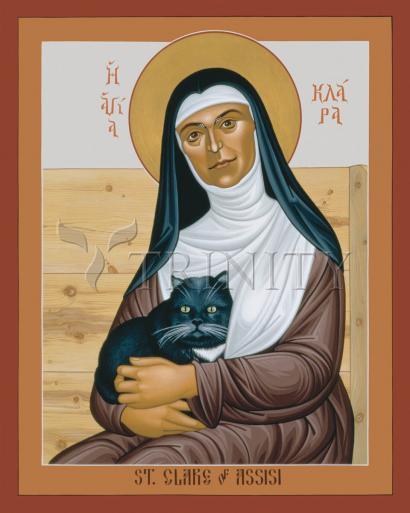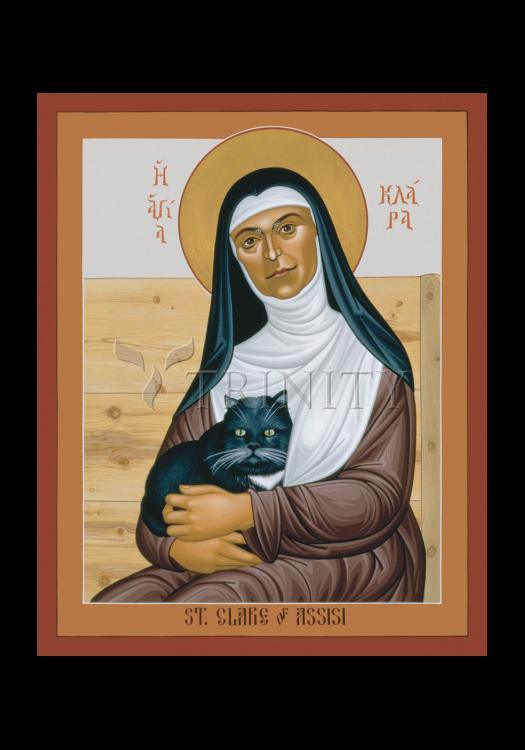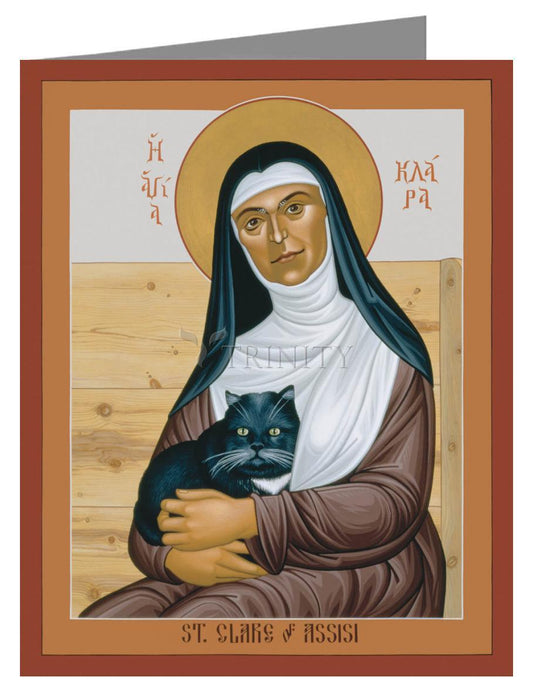One of the more sugary movies made about Francis of Assisi (October 4) pictures Clare as a golden-haired beauty floating through sun-drenched fields, a sort of one-woman counterpart to the new Franciscan Order.
The beginning of her religious life was indeed movie material. Having refused to marry at 15, she was moved by the dynamic preaching of Francis. He became her lifelong friend and spiritual guide.
At 18, she escaped one night from her father's home, was met on the road by friars carrying torches, and in the poor little chapel called the Portiuncula received a rough woolen habit, exchanged her jeweled belt for a common rope with knots in it, and sacrificed the long tresses to Francis' scissors. He placed her in a Benedictine convent, which her father and uncles immediately stormed in rage. She clung to the altar of the church, threw aside her veil to show her cropped hair and remained adamant.
Sixteen days later her sister Agnes joined her. Others came. They lived a simple life of great poverty, austerity and complete seclusion from the world, according to a Rule which Francis gave them as a Second Order (Poor Clares). Francis obliged her under obedience at age 21 to accept the office of abbess, one she exercised until her death.
The nuns went barefoot, slept on the ground, ate no meat and observed almost complete silence. (Later Clare, like Francis, persuaded her sisters to moderate this rigor: "Our bodies are not made of brass.") The greatest emphasis, of course, was on gospel poverty. They possessed no property, even in common, subsisting on daily contributions. When even the pope tried to persuade her to mitigate this practice, she showed her characteristic firmness: "I need to be absolved from my sins, but I do not wish to be absolved from the obligation of following Jesus Christ."
Contemporary accounts glow with admiration of her life in the convent of San Damiano in Assisi. She served the sick, waited on table, washed the feet of the begging nuns. She came from prayer, it was said, with her face so shining it dazzled those about her. She suffered serious illness for the last 27 years of her life. Her influence was such that popes, cardinals and bishops often came to consult her"she never left the walls of San Damiano.
Francis always remained her great friend and inspiration. She was always obedient to his will and to the great ideal of gospel life which he was making real.
A well-known story concerns her prayer and trust. She had the Blessed Sacrament placed on the walls of the convent when it faced attack by invading Saracens. "Does it please you, O God, to deliver into the hands of these beasts the defenseless children I have nourished with your love? I beseech you, dear Lord, protect these whom I am now unable to protect." To her sisters she said, "Don't be afraid. Trust in Jesus." The Saracens fled.
Born: July 16, 1194 at Assisi, Italy
Died: August 11, 1253 of natural causes
Canonized: September 26, 1255 by Pope Alexander IV
Name Meaning: Bright; brilliant
Readings:
Go forth in peace, for you have followed the good road. Go forth without fear, for he who created you has made you holy, has always protected you, and loves you as a mother. Blessed be you, my God, for having created me.
"Saint Clare of Assisi
O wondrous blessed clarity of Clare!
In life she shone to a few;
after death she shines on the whole world!
On earth she was a clear light;
Now in heaven she is a brilliant sun.
O how great the vehemence of the
brilliance of this clarity!
On earth this light was indeed kept
within cloistered walls,
yet shed abroad its shining rays;
It was confined within a convent cell,
yet spread itself through the wide world.
"Pope Innocent IV
He Christ is the splendor of eternal glory, "the brightness of eternal light, and the mirror without cloud."
Behold, I say, the birth of this mirror. Behold Christ's poverty even as he was laid in the manger and wrapped in swaddling clothes. What wondrous humility, what marvelous poverty! The King of angels, the Lord of heaven and earth resting in a manger! Look more deeply into the mirror and meditate on his humility, or simply on his poverty. Behold the many labors and sufferings he endured to redeem the human race. Then, in the depths of this very mirror, ponder his unspeakable love which caused him to suffer on the wood of the cross and to endure the most shameful kind of death. The mirror himself, from his position on the cross, warned passers-by to weigh carefully this act, as he said:
"All of you who pass by this way, behold and see if there is any sorrow like mine." Let us answer his cries and lamentations with one voice and one spirit: "I will be mindful and remember, and my soul will be consumed within me."
"Excerpts from a letter to Blessed Agnes of Prague by Saint Clare of Assisi




















